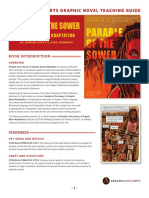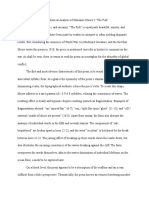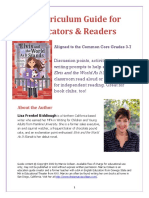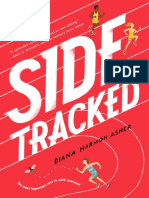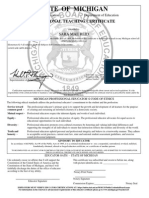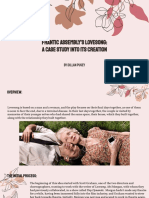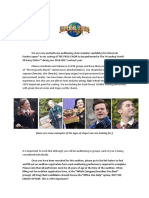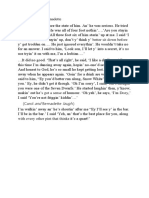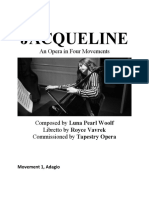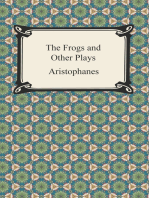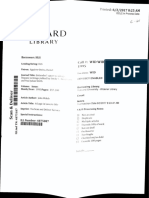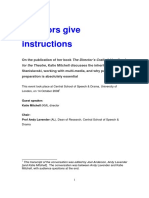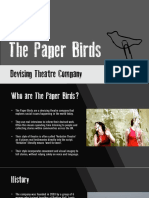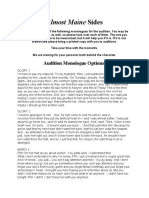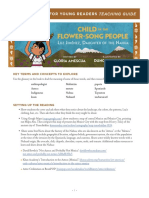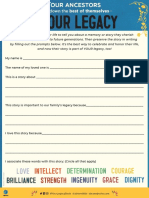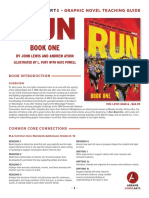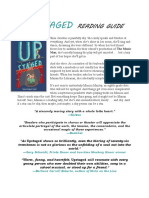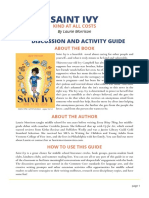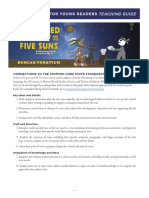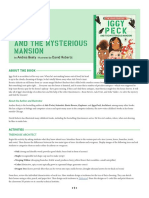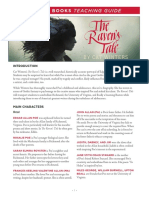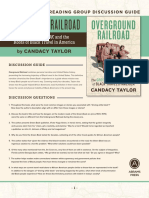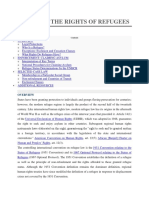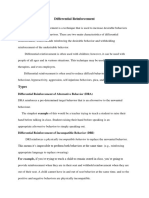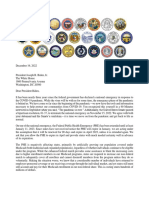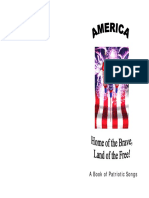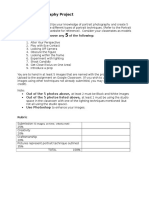Professional Documents
Culture Documents
A Greyhound of A Girl - Reading Guide
A Greyhound of A Girl - Reading Guide
Uploaded by
Abrams BooksOriginal Title
Copyright
Available Formats
Share this document
Did you find this document useful?
Is this content inappropriate?
Report this DocumentCopyright:
Available Formats
A Greyhound of A Girl - Reading Guide
A Greyhound of A Girl - Reading Guide
Uploaded by
Abrams BooksCopyright:
Available Formats
Reading Guide:
A GREYHOUND OF A GIRL
Q&A with Roddy Doyle – Page 2
Family Tree – Page 5
Roddy Doyle Talks about Writing Dialogue – Page 6
The Journey: Map – Page 7
Irish to English Dictionary – Page 8
Discussion Questions – Page 9
Q&A with Roddy Doyle
What inspired you to write a novel about four generations of women?
Two fictional women came together in my head. I wanted to write about a girl,
just before she officially becomes a teenager, who feels and anticipates the
changes that are happening to her. So, that was one of the women. I called her
Mary. The other woman was inspired by my grandmother. She died in 1928,
when my mother was a little girl. Obviously, I never knew her. I always wondered
about her—what she’d been like and what she would have been like if she’d
lived to be an older woman. I decided to make her Mary’s great-grandmother.
Between these two women there had to be two more generations—Mary’s
mother and grandmother. That made four: girl, mother, grandmother, and great-
grandmother. They’d be very different but would have a lot in common too.
Are the characters in A GREYHOUND OF A GIRL inspired by women in your family
or life?
Tansey, the great-grandmother, is inspired by my grandmother, whose name
was actually Ellen. As I said, she died in 1928, of the flu. My mother was only
three when it happened. It’s a sad story. What makes it sadder is the fact that
my mother grew up knowing almost nothing about her. She couldn’t remember
her face, although she could remember her mother’s hands doing things—
peeling an apple, for example. She didn’t even know her mother’s name and
knew nothing about where she’d come from or where the rest of her mother’s
family lived. When my mother was much older, in her fifties, she found letters
addressed to my grandfather. They’d been written in the 1920s, and they all
came from America—from New York. The surname on most of them was
Beekman. My mother told someone she knew who worked for the Irish
telephone service, who then photocopied all the Beekman pages from the New
York phone directory. My mother wrote to all of them. Two answered. She
discovered she had cousins living on Long Island: her mother’s family had
emigrated together and settled there. My mother visited them, and they came
to Ireland. She was delighted to find this family, and they were delighted to have
Irish cousins. It was a very happy ending to a sad story. Tansey—the ghost—is
inspired by that story. I wanted her to come back to life—like my mother’s family
had in my mother’s life.
Want to read more? Check out A Greyhound of a Girl by Roddy Doyle (now in paperback: $7.95!) — 2
Summer 2012 Kid’s Indie Next List Children’s Selection, with starred reviews from Kirkus and Booklist.
For information, interviews, and more:
Please contact Morgan Dubin: [email protected], 212-229-7128
What made you choose the east coast of Ireland as the setting for the women’s
journey?
There are two reasons. Firstly, the more obvious journey in Irish stories is from
east to west, from Dublin City, on the east coast, to the beautiful, wild landscape
of the west, in Galway. It’s been done many times, and I wanted to go for a
different route. Secondly, my mother’s father and mother both came from
Wexford, in the southeast of the country. I know it very well, and love it. When I
was a child, it seemed like a long journey there, although it was only seventy-five
miles. But the roads were bad; the cars were slower. Today, the journey can be
done very quickly—it’s a straight highway all the way. I thought it would be
amusing, and interesting, for the older women to experience a different kind of
trip, to the same place—if that makes sense. The house the women visit, the
ruin, is inspired by a house that it actually isn’t a ruin at all, that is still lived in by
my mother’s cousins.
Is there someone you wish would visit you in ghost form? What would you talk
about?
I never really knew my grandparents. They were either dead before I was born or
died soon after. I’d love to meet one, or all, of them now and chat with them as
an adult. My grandfathers were both involved in the War of Independence here
in Ireland, in the early 1920s. My father’s mother I remember a bit. She reared
not only her own large family but the families of two of her sisters as well. She
lived in a house with no running water, but she was very elegant. Judging by the
stories I grew up hearing, they were all interesting, funny people who lived very
full lives.
This book illustrates the importance of family. How important is family in your
life?
I grew up in a family, and I now have a family of my own. So my own family is
vital to me. But I don’t think I have an opinion on family life outside of my own.
When I start a story with a character, one of the first questions I have to ask
myself is, “Does she have brothers or sisters?” and “What are they like—older or
younger?” The fictional family starts to grow, because it’s part of the story.
Want to read more? Check out A Greyhound of a Girl by Roddy Doyle (now in paperback: $7.95!) — 3
Summer 2012 Kid’s Indie Next List Children’s Selection, with starred reviews from Kirkus and Booklist.
For information, interviews, and more:
Please contact Morgan Dubin: [email protected], 212-229-7128
Whether you are writing for adults or children, you often write about children
and teens. What in particular interests you about young people, and how has
your own childhood influenced your writing?
I like the way young people take command of their lives, especially the language.
They invent new words; they put a new rhythm on old phrases; they put great
energy into how they express themselves. Even one angry word from a teenager
can seem to carry great confidence and hope. At the moment, I’m writing a
novel for adults about a man in his late forties. I particularly enjoy writing about
him in the company of his children—how they express themselves, how they get
across their own ideas, how their personalities are captured in the words that
they choose—or, in this case, the words I chose for them.
Any writer will tell you that their childhood is an important part of their toolkit—
or something like that! I’ve used my school days, the locality I grew up in, the
way it changed from rural to urban, the music I used to love—all sorts of small
moments from my childhood and teen years push their way to the front of my
head when I’m writing. I often push them back!
You run a writing center for underprivileged children and teens in Dublin. How did
writing make a difference in your life, and what difference do you think it can
make in the lives of young people?
The writing center, called Fighting Words, is actually for all young people,
regardless of their circumstances. We see creative writing as an important
human right. Children who are otherwise privileged often don’t get the
opportunity to express themselves creatively; as they get older, creativity is
pushed aside and considered unimportant. It’s a different kind of poverty.
The most striking thing about writing, I find as I get older, is that your life can be
your research. The happy moments, the awful ones—they all can inspire, or form
part of, a piece of writing. I’m not talking about autobiography—I’ve no real
interest in it. I have a character listening to a piece of music: what words would I
use to describe his reaction to it? I have a character, a child, standing in front of
a refrigerator: what does she hope to find in there? These are questions we can
all answer because we’ve lived them. It’s a question of selecting the words.
Want to read more? Check out A Greyhound of a Girl by Roddy Doyle (now in paperback: $7.95!) — 4
Summer 2012 Kid’s Indie Next List Children’s Selection, with starred reviews from Kirkus and Booklist.
For information, interviews, and more:
Please contact Morgan Dubin: [email protected], 212-229-7128
Family Tree
Want to read more? Check out A Greyhound of a Girl by Roddy Doyle (now in paperback: $7.95!) — 5
Summer 2012 Kid’s Indie Next List Children’s Selection, with starred reviews from Kirkus and Booklist.
For information, interviews, and more:
Please contact Morgan Dubin: [email protected], 212-229-7128
Roddy Doyle Talks about Writing Dialogue
“I see people in terms of dialogue, and I believe that people are
their talk.” —Roddy Doyle.
I live in a city of talkers. People here in Dublin talk on buses, in trains, in queues—
everywhere. When I started writing my first book, I decided to write about a group of
young people who were forming a band. It struck me that the way to make them seem
real was not to describe their physical appearances but to get them talking. Writing is
words. My characters would be words too.
If you’re writing dialogue, the question to ask constantly is: Does my character talk like
that? Write the dialogue first, and then judge it. Read it out loud. Make changes. Ask
yourself: What little thing can I do make this piece of dialogue seem like the words of
one particular person and no one else? For example, is there a word or phrase that they
use more than other people do? Listen to real people, and rob their words.
Want to read more? Check out A Greyhound of a Girl by Roddy Doyle (now in paperback: $7.95!) — 6
Summer 2012 Kid’s Indie Next List Children’s Selection, with starred reviews from Kirkus and Booklist.
For information, interviews, and more:
Please contact Morgan Dubin: [email protected], 212-229-7128
The Journey
Want to read more? Check out A Greyhound of a Girl by Roddy Doyle (now in paperback: $7.95!) — 7
Summer 2012 Kid’s Indie Next List Children’s Selection, with starred reviews from Kirkus and Booklist.
For information, interviews, and more:
Please contact Morgan Dubin: [email protected], 212-229-7128
Irish to English Dictionary
cinema (p. 12) – Movie theatre.
eejits (p. 171) — Irish slang. An eejit is an idiot, fool, or imbecile. The word, in the right
hands, can be quite affectionate. “You’re an eejit,” if delivered with a smile, can actually
mean “I love you.” But practice first before you say it.
grand (p. 32) – Good, of acceptable quality. “Grand” in Ireland doesn’t mean anything
special, it just meant things are “fine” or “okay.”
kilometers (p. 5) — A unit of measurement in the metric system equal to 1,000 meters.
A kilometer is five-eighths of a mile.
lorry (p. 4) — A motor vehicle designed to transport cargo; a truck.
Lynx (p. 21) — The name for Axe grooming products in Ireland, the U.K., South Africa,
and Australia.
moved house (p. 5) — Moving from one house to another.
mucky (p. 29) — Covered in mud or dirt, filthy.
telly (p. 25) — Slang for television. Why use four syllables when two will do?
quare (p. 36) — “Quare” can mean “strange” or “great,” or both. If we like something
we eat or drink, we often say, “That’s quare stuff.” Older people say much more than
young people—maybe because they eat and drink more.
yeuk (p. 51) — An expression often used when we see something horrible, especially if
it’s rotten or blood-covered. The American equivalent is “yuck.” In this case, Mary uses
the word as the horrible thing itself. So, the “yeuk” is the rotten squashed banana
covering her schoolbooks.
Want to read more? Check out A Greyhound of a Girl by Roddy Doyle (now in paperback: $7.95!) — 8
Summer 2012 Kid’s Indie Next List Children’s Selection, with starred reviews from Kirkus and Booklist.
For information, interviews, and more:
Please contact Morgan Dubin: [email protected], 212-229-7128
Discussion Questions
What is the significance of greyhounds in the story?
If you could go back in time and ask one person one question, who would it be and what
would you ask?
What is the role of the flu in the story? How does it help frame the differences in the
four generations of women?
Ghosts are represented differently by different authors. If you were writing a ghost
story, what would your ghost(s) look like? What would be the details of their haunting?
Would they feel the cold, for instance? Be otherworldly-looking or ordinary?
What is something all four women in A GREYHOUND OF A GIRL have in common? How
does this shape the story?
The characters in the book, particularly Mary, are often described as “cheeky.” How
does this character trait impact how the story unfolds?
What role do the men (fathers and brothers) play in the book?
Want to read more? Check out A Greyhound of a Girl by Roddy Doyle (now in paperback: $7.95!) — 9
Summer 2012 Kid’s Indie Next List Children’s Selection, with starred reviews from Kirkus and Booklist.
For information, interviews, and more:
Please contact Morgan Dubin: [email protected], 212-229-7128
You might also like
- AinP AirswimmingDocument3 pagesAinP Airswimmingdevam.zalawadia27No ratings yet
- THE PARTY - TextoDocument83 pagesTHE PARTY - Textobruno.cavalcanti.prNo ratings yet
- A Bitter FateDocument21 pagesA Bitter FateChayce Solchaga50% (2)
- I Am Courage Activity SheetsDocument3 pagesI Am Courage Activity SheetsAbrams Books67% (3)
- Kent State Teaching GuideDocument8 pagesKent State Teaching GuideAbrams Books100% (2)
- Parable of The Sower Teaching GuideDocument5 pagesParable of The Sower Teaching GuideAbrams Books100% (16)
- The Last M&M SamuraiDocument1 pageThe Last M&M SamuraiLandNo ratings yet
- Soul Food Sunday Activity SheetsDocument4 pagesSoul Food Sunday Activity SheetsAbrams BooksNo ratings yet
- Metaphorical Analysis of Marianne Moore's "The Fish"Document3 pagesMetaphorical Analysis of Marianne Moore's "The Fish"Anonymous 8mdtF97No ratings yet
- Guantanamo Voices Teaching GuideDocument4 pagesGuantanamo Voices Teaching GuideAbrams BooksNo ratings yet
- ELVIS AND THE WORLD AS IT STANDS Curriculum GuideDocument10 pagesELVIS AND THE WORLD AS IT STANDS Curriculum GuideAbrams BooksNo ratings yet
- BREAKING THROUGH THE CLOUDS Curriculum GuideDocument6 pagesBREAKING THROUGH THE CLOUDS Curriculum GuideAbrams BooksNo ratings yet
- Sidetracked Discussion QuestionsDocument13 pagesSidetracked Discussion QuestionsAbrams BooksNo ratings yet
- Anima (Her Soul) (Amelia Rosselli) PDFDocument63 pagesAnima (Her Soul) (Amelia Rosselli) PDFRyan KenneyNo ratings yet
- 4-4-2011 Wilton - 100 Words For SnowDocument2 pages4-4-2011 Wilton - 100 Words For SnowCarla Luján Di BiaseNo ratings yet
- Character Analysis: Lost in Yonkers Bella: As A Thirty-Five YearDocument9 pagesCharacter Analysis: Lost in Yonkers Bella: As A Thirty-Five Yeardyobcrystal0% (1)
- Ray MonologueDocument2 pagesRay MonologueDaniel NixonNo ratings yet
- Munro Meneseteung AnnotatedDocument15 pagesMunro Meneseteung Annotatedknslf100% (1)
- The Real Inspector Hound - ContextDocument3 pagesThe Real Inspector Hound - ContextAmy HannaNo ratings yet
- Snow Birds Teaching GuideDocument6 pagesSnow Birds Teaching GuideAbrams BooksNo ratings yet
- Big Foot and Little Foot Series Teaching GuideDocument8 pagesBig Foot and Little Foot Series Teaching GuideAbrams BooksNo ratings yet
- SANS1700 7 7 (Looseleaf)Document13 pagesSANS1700 7 7 (Looseleaf)Darryl007No ratings yet
- Teaching CertificateDocument1 pageTeaching Certificateapi-240193138No ratings yet
- Somebody That I Used To Know Ukulele TabsDocument5 pagesSomebody That I Used To Know Ukulele Tabsafcabanas100% (2)
- The 7 Stages of GrievingDocument9 pagesThe 7 Stages of GrievingKevin AtaallaNo ratings yet
- Critical Work Surrounding Marina Carr's by The Bog of CatsDocument7 pagesCritical Work Surrounding Marina Carr's by The Bog of CatsBBOCresources50% (2)
- Frantic Assembly's Lovesong: A Case Study Into Its Creation: by Dillan PuseyDocument23 pagesFrantic Assembly's Lovesong: A Case Study Into Its Creation: by Dillan Puseyapi-606285565No ratings yet
- A Festival of One Acts ProgramDocument2 pagesA Festival of One Acts ProgramJackNo ratings yet
- 2016 Frog Choir Candidate LetterDocument5 pages2016 Frog Choir Candidate LetterJack SaundersNo ratings yet
- The Collected Plays - Berkoff, Steven - Volume 2Document248 pagesThe Collected Plays - Berkoff, Steven - Volume 2tradingaopNo ratings yet
- Spalding Gray Last InterviewDocument14 pagesSpalding Gray Last Interviewjennifer_lowe_30No ratings yet
- "Q" A Farce in One ActDocument19 pages"Q" A Farce in One ActhamsasohamNo ratings yet
- CopiadeShirleyValentine SlangandColloquialismDocument10 pagesCopiadeShirleyValentine SlangandColloquialismJulieta MaffeiNo ratings yet
- Jamaica Kincaid - in The NightDocument4 pagesJamaica Kincaid - in The NightJillian Zoe JohannsenNo ratings yet
- In Her ShoesDocument3 pagesIn Her ShoesPauza PlusNo ratings yet
- If Thou Must Love MeDocument2 pagesIf Thou Must Love MeAugustaLeigh100% (1)
- Lady Macbeth MonologueDocument2 pagesLady Macbeth MonologueTONY STARKNo ratings yet
- Yount Cerda Translation All Cats Are GrayDocument28 pagesYount Cerda Translation All Cats Are GrayAndra YountNo ratings yet
- Riders To The SeaDocument4 pagesRiders To The Seaiarilangsyngkli0No ratings yet
- A Doll's HouseDocument6 pagesA Doll's HouseDarshana KumaraNo ratings yet
- Stags and HensDocument1 pageStags and HensGrace GallowayNo ratings yet
- Extracts From The Diary of Anne FrankDocument1 pageExtracts From The Diary of Anne FrankDanny TNo ratings yet
- Poems by Brian PattenDocument20 pagesPoems by Brian PattenJacob CarrollNo ratings yet
- SummerOfTheSeventeenthDoll-NewEdition AVAILABLEDocument111 pagesSummerOfTheSeventeenthDoll-NewEdition AVAILABLEpuja sarmah0% (1)
- Jacqueline Libretto 080317Document21 pagesJacqueline Libretto 080317Devin MatthewsNo ratings yet
- Eugene O'Neill TimelineDocument3 pagesEugene O'Neill TimelineCrystal PerezNo ratings yet
- Henrik Ibsen - Plays and ProblemsDocument398 pagesHenrik Ibsen - Plays and Problemsariha raheeNo ratings yet
- Jumpers MonologueDocument2 pagesJumpers MonologueNora Krupp0% (1)
- Narrative Structure and Devices: WritingDocument11 pagesNarrative Structure and Devices: WritingSanthul amaradiwakaraNo ratings yet
- MACHINAL PresenationDocument5 pagesMACHINAL PresenationEftichia SpyridakiNo ratings yet
- The Seagull Script - Act 3 and 4Document25 pagesThe Seagull Script - Act 3 and 4Susan DunnNo ratings yet
- Lorca Whitman León Felipe A Logic in Lorca's Ode WalshDocument28 pagesLorca Whitman León Felipe A Logic in Lorca's Ode WalshDaniel Aguirre OteizaNo ratings yet
- Borrowed Faces: The Effect of Whitewashing Asian Roles in Theatre and CinemaDocument37 pagesBorrowed Faces: The Effect of Whitewashing Asian Roles in Theatre and CinemaJennifer M. YooNo ratings yet
- By Louis NowraDocument36 pagesBy Louis NowraXavierNo ratings yet
- Ten Minute PlayDocument3 pagesTen Minute Playnueva_madreNo ratings yet
- Background Questions On "Philadelphia, Here I Come."Document3 pagesBackground Questions On "Philadelphia, Here I Come."BruceNo ratings yet
- Final Victory NotesDocument17 pagesFinal Victory NotesKlara S100% (1)
- How To Read A PlayDocument1 pageHow To Read A PlayE ANo ratings yet
- Report in HumanitiesDocument41 pagesReport in HumanitiesHarold AsuncionNo ratings yet
- CEN KM JournalDocument23 pagesCEN KM JournalAlina MasgrasNo ratings yet
- Calderon de La Barca - Life Is A DreamDocument121 pagesCalderon de La Barca - Life Is A DreamAlexandra PopoviciNo ratings yet
- The PossessedDocument160 pagesThe PossessedMayaBehatiNo ratings yet
- Written Report - JapaneseDocument25 pagesWritten Report - JapaneseMae RiveraNo ratings yet
- THE CRYSTAL SPIDER, RachildeDocument8 pagesTHE CRYSTAL SPIDER, RachildemelmothNo ratings yet
- The PAPER BIRDS An Introduction Powerpoint 2020Document16 pagesThe PAPER BIRDS An Introduction Powerpoint 2020Danny & Rich Pals4LifeNo ratings yet
- Almost Maine Audition Monologue SidesDocument3 pagesAlmost Maine Audition Monologue SidesEllie GriffinNo ratings yet
- ENGL 201: Dr. N. Langah: The ExchangeDocument14 pagesENGL 201: Dr. N. Langah: The ExchangeMargilyn RamosNo ratings yet
- The Sea-Gull: Anton CheckovDocument70 pagesThe Sea-Gull: Anton CheckovAditya SihmarNo ratings yet
- Fuddy Meers Script AnalysisDocument1 pageFuddy Meers Script AnalysisbixgorinNo ratings yet
- IF YOU ARE THE DREAMER Activity KitDocument10 pagesIF YOU ARE THE DREAMER Activity KitAbrams BooksNo ratings yet
- CHILD OF THE FLOWER-SONG PEOPLE Teaching GuideDocument6 pagesCHILD OF THE FLOWER-SONG PEOPLE Teaching GuideAbrams BooksNo ratings yet
- BLACK: THE MANY WONDERS OF MY WORLD Activitiy SheetsDocument4 pagesBLACK: THE MANY WONDERS OF MY WORLD Activitiy SheetsAbrams Books100% (1)
- WAVE Discussion GuideDocument6 pagesWAVE Discussion GuideAbrams BooksNo ratings yet
- YOUR LEGACY Intergenerational Story ActivityDocument2 pagesYOUR LEGACY Intergenerational Story ActivityAbrams BooksNo ratings yet
- Book One: by John Lewis and Andrew AydinDocument6 pagesBook One: by John Lewis and Andrew AydinAbrams BooksNo ratings yet
- Upstaged Reading GuideDocument7 pagesUpstaged Reading GuideAbrams BooksNo ratings yet
- Saint Ivy Discussion and Activity GuideDocument6 pagesSaint Ivy Discussion and Activity GuideAbrams BooksNo ratings yet
- Feathered Serpent and The Five Suns Teaching GuideDocument6 pagesFeathered Serpent and The Five Suns Teaching GuideAbrams Books100% (1)
- Up For Air Teaching GuideDocument5 pagesUp For Air Teaching GuideAbrams Books0% (1)
- The Chance To Fly Reading GuideDocument5 pagesThe Chance To Fly Reading GuideAbrams Books0% (1)
- Pigskins To Paintbrushes Teaching GuideDocument3 pagesPigskins To Paintbrushes Teaching GuideAbrams BooksNo ratings yet
- Code Breaker, Spy Hunter Teaching GuideDocument14 pagesCode Breaker, Spy Hunter Teaching GuideAbrams BooksNo ratings yet
- This Train Is Being Held Teaching GuideDocument7 pagesThis Train Is Being Held Teaching GuideAbrams BooksNo ratings yet
- Iggy Peck and The Mysterious Mansion Teaching GuideDocument4 pagesIggy Peck and The Mysterious Mansion Teaching GuideAbrams BooksNo ratings yet
- The Stuff Between The Stars Curriculum GuideDocument7 pagesThe Stuff Between The Stars Curriculum GuideAbrams BooksNo ratings yet
- The Raven's Tale Teaching GuideDocument6 pagesThe Raven's Tale Teaching GuideAbrams BooksNo ratings yet
- Overground Railroad Teaching GuideDocument2 pagesOverground Railroad Teaching GuideAbrams BooksNo ratings yet
- Drawing The Vote Teaching GuideDocument6 pagesDrawing The Vote Teaching GuideAbrams BooksNo ratings yet
- Read An Excerpt From ENDGAME by Rep. Eric SwalwellDocument7 pagesRead An Excerpt From ENDGAME by Rep. Eric SwalwellAbrams Books100% (5)
- MMN 02 2021 07 01 2021 Gulf of GuineaDocument3 pagesMMN 02 2021 07 01 2021 Gulf of GuineaDelfin RegisNo ratings yet
- Refugees and AssylumDocument18 pagesRefugees and AssylumCherry Ann Bawagan Astudillo-BalonggayNo ratings yet
- Differential Reinforcement - FinalDocument5 pagesDifferential Reinforcement - FinalAli Aman QaisarNo ratings yet
- Ignoratio ElenchiDocument1 pageIgnoratio ElenchiArionPamcenjeNo ratings yet
- Invoice 79Document1 pageInvoice 79ragavkumar6679No ratings yet
- File 1Document1 pageFile 1whatsappcricketstatusNo ratings yet
- Disadvantages of BioinformaticsDocument1 pageDisadvantages of BioinformaticsJebatAl-KelantaniNo ratings yet
- Joint Letter To President Biden On The Public Health EmergencyDocument3 pagesJoint Letter To President Biden On The Public Health EmergencyPennCapitalStarNo ratings yet
- Allcv Service Manual: Propeller ShaftDocument10 pagesAllcv Service Manual: Propeller ShaftMohan CharanchathNo ratings yet
- Permanent Way Component PartsDocument39 pagesPermanent Way Component PartsFarooq Maniyar100% (1)
- Franchise Brochure - NirulasDocument13 pagesFranchise Brochure - NirulasAnuj BhargavaNo ratings yet
- Smart City ProjectDocument22 pagesSmart City ProjectTaukir SiddiqueNo ratings yet
- Artificial Intelligence-Opportunities and Challenges For TheDocument9 pagesArtificial Intelligence-Opportunities and Challenges For TheChris CocNo ratings yet
- Review Present Simple and Present ContinuousDocument6 pagesReview Present Simple and Present ContinuousAnnju Hime Patiño Páez100% (1)
- GR No 162934Document9 pagesGR No 162934Ana RamirezNo ratings yet
- Songbook PatrioticDocument6 pagesSongbook Patrioticapi-54606121533% (3)
- The Odyssey: By: HomerDocument7 pagesThe Odyssey: By: HomerSteven ArajaNo ratings yet
- Portrait AssignmentDocument1 pagePortrait Assignmentapi-240963149No ratings yet
- Answers To Typical QuestionsDocument30 pagesAnswers To Typical QuestionsErik AllenNo ratings yet
- 3 8 PrepositionsDocument5 pages3 8 PrepositionsPratyuusha PunjabiNo ratings yet
- RankingDocument11 pagesRankingZerlene RuchandaniNo ratings yet
- Installatie en Onderhouds Manual CPAN XHE 3Document52 pagesInstallatie en Onderhouds Manual CPAN XHE 3valerivelikovNo ratings yet
- BCS Project GuidanceDocument2 pagesBCS Project GuidancestarryskiesNo ratings yet
- FibreC PDFDocument38 pagesFibreC PDFseljak_veseljakNo ratings yet
- Bhayu H. 349655122Document16 pagesBhayu H. 349655122Green Sustain EnergyNo ratings yet
- London Directory (Ing)Document64 pagesLondon Directory (Ing)Marcos F. M.No ratings yet
- Recruitment Selection and RetentionDocument17 pagesRecruitment Selection and Retentionmjkhumalo100% (4)





